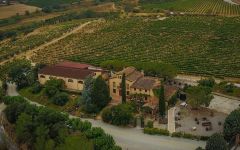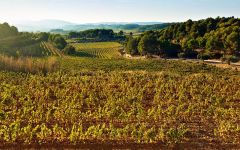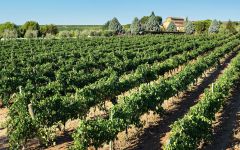Castellroig Cava Brut
-
Wilfred
Wong



Product Details
Your Rating
Somm Note
Winemaker Notes
Blend: 45% Xarel-lo, 30% Macabeo, 25% Parellada
Professional Ratings
-
Wilfred Wong of Wine.com
Offering nice complexity, the Castellroig Brut Cava is pleasing and fine sparkling wine. The wine's freshness and smooth aftertaste make it beautiful aperitif wine. (Tasted: October 5, 2017, San Francisco, CA)





With complete dedication to producing wines reflective of the soil, the concept of ‘Vins de Terrer’ was born. A location 40km south of Barcelona affords a privileged location with a valley protected by mountains and a moderate climate due to the close proximity to the Mediterranean coast. Marine sediment embedded in the soil promotes vines with a longer, slower ripening cycle and added complexity in the grapes. The Sabaté I Coca estate is distributed across 18 terroirs, 62 parcels, and 40 hectares throughout the Valle del Bitlles. Grapes are carefully selected for each bottling and hand harvested from each of these terroirs.
Castellroig achieves the ultimate expressions of these different parcels with extra focus on the native Xarel-lo grape. Capable of achieving the greatest aromatics, body, and acidity, Xarel-lo represents the most favorable varietal in the Cava blend.

A term typically reserved for Champagne and Sparkling Wines, non-vintage or simply “NV” on a label indicates a blend of finished wines from different vintages (years of harvest). To make non-vintage Champagne, typically the current year’s harvest (in other words, the current vintage) forms the base of the blend. Finished wines from previous years, called “vins de reserve” are blended in at approximately 10-50% of the total volume in order to achieve the flavor, complexity, body and acidity for the desired house style. A tiny proportion of Champagnes are made from a single vintage.
There are also some very large production still wines that may not claim one particular vintage. This would be at the discretion of the winemaker’s goals for character of the final wine.

What is Cava?
Spain adopted the word, cava, which technically means ‘cellar’ in Catalan, to describe their sparkling wines made using the traditional method. While this style was first created outside of Spain in the 1600s, its birthplace inside of Spain came in 1872 when Jose Raventós of Codorníu first produced traditional method sparkling wine in the town of San Sadurní d’Anoia. Uniquely, the Cava denomination isn’t restricted to one geographical area but rather, it spans eight total wine regions. However, about 90% of Spain’s total production of Cava, Spanish sparkling wine happens within Catalonia, and about 75% is produced within the borders of San Sadurní d’Anoia, inside the smaller Catalan region of Penedès. In 2019, Spain registered nearly 38,000 hectares of vineyards for Cava production, compared to just under 34,000 in Champagne.
How is Cava sparkling wine made?
Cava, like many other sparkling wines of the world is made using the traditional method, or "Champagne method," or método tradicional in Spanish, in which the second fermentation (the one that makes the bubbles) takes place inside the bottle. With this method, spent yeast cells remain in contact with the wine during bottle aging, giving it a creamy mouthful, a toasted bread or brioche quality and in many cases, the capacity to age.
What are the Cava wine grapes?
The mainstay Cava grape varieties include Macabeo, Parellada, and Xarel-lo. Macabeo, also known as Viura, lends pleasant aromatics to the blend, while Parellada adds acidity and finesse. Xarel-lo is the grape that gives body, earth and greengage characteristics to Cava. Occasionally Chardonnay is used as a blending grape or sole variety in making Cava wine. Governmental inclusion approval was awarded in 1986 but still, Chardonnay makes up only a fraction of total vineyard area. For rosé, in Spanish called rosado, the local Trepat and Garnacha can be used, along with Pinot Noir (first permitted in 1998 for rosado and in 2007 for white Cavas).
Cava Tasting Profile
Since Cava is a sparkling wine produced on the Mediterranean where temperatures are warmer and there is more sunshine compared with Champagne, you can expect that Cava sparkling wine will generally have a gentler acid profile compared with its French counterpart. Furthermore, especially when the indigenous varieties are used, common Cava flavors will include citrus peel, fennel, wildflower, lemon blossom and flint or saline. Most Cava is produced in the Brut style, so dry, with a slightly rounder finish that balances brightness with brioche notes and supple fruit. Brut Nature or Zero Dosage examples are bone dry, whereas Extra-Dry Cava will be slightly sweet and a Demi-Sec Cava will have the highest sweetness level.
Cava Pairings
One of the best things about pairing Cava wine is you can drink it on its own or with just about any food! But if you want to focus on bringing out Cava's uniquely brilliant bouquet and citrus notes, rich or seafood-centric dishes are perfect food pairings for Cava. Try Cava with butter poached lobster, seafood risotto, puff pastry and caramelized onions or fried chicken.
